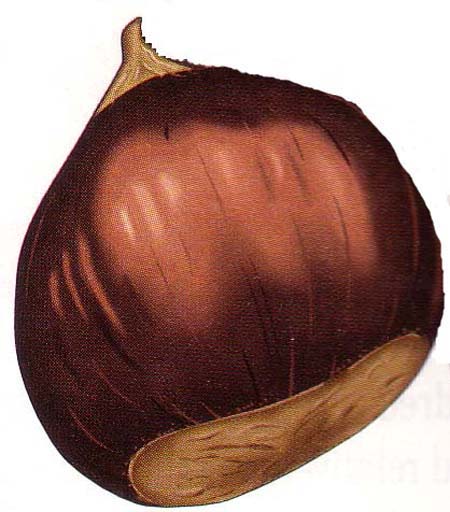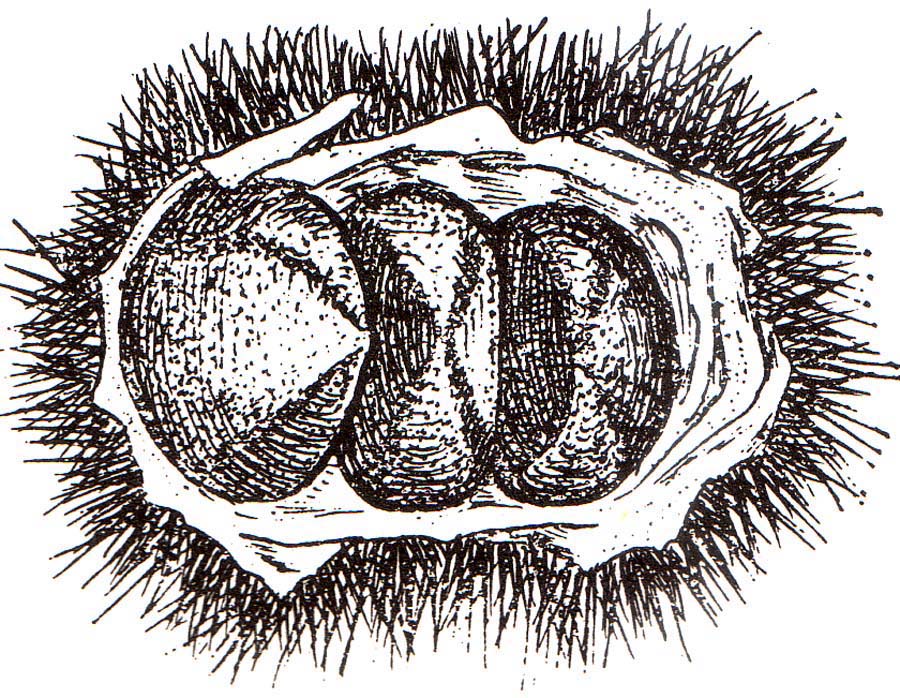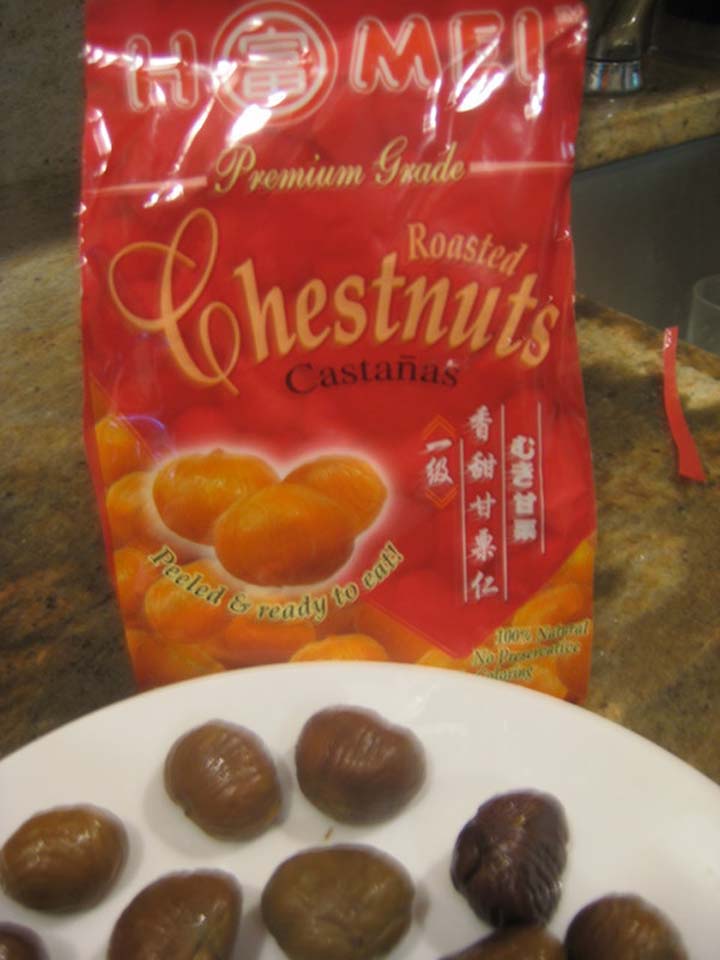
| What is Flavor and Fortune? |
| How do I subscribe? |
| How do I get past issues? |
| How do I advertise? |
| How do I contact the editor? |
Read 12955360 times
Connect me to:
| Home |
| Articles |
| Book reviews |
| Letters to the Editor |
| Newmans News and Notes |
| Recipes |
| Restaurant reviews |
| Article Index (all years, slow) |
| List of Article Years |
| Article Index (2025) |
| Article Index (last 2 years) |
| Things others say |
| Related Links |
| Log In... |
| Authors |
| Categories & Topics |
Chestnuts Intrigue
| by Jacqueline M. Newman |
Vegetables and Vegetarian Foods
Summer Volume: 2012 Issue: 19(2) page(s): 10 - 12

 Two previous articles, one in 2004, the other in 2008, and still we receive many queries about chestnuts. In winter they are found raw and in their shell in just about every supermarket; year-round they can be located peeled, pre-cooked, and packed plastic and foil pouches in every Asian market. Check them out that last way before the recipes in this article. That saves lots of time.
Two previous articles, one in 2004, the other in 2008, and still we receive many queries about chestnuts. In winter they are found raw and in their shell in just about every supermarket; year-round they can be located peeled, pre-cooked, and packed plastic and foil pouches in every Asian market. Check them out that last way before the recipes in this article. That saves lots of time.
Most queries are about using them. Folks want to know are they really totally pre-cooked and ready to put in a stir-fry dish at the very last moment in those foil-type packets? Can they really be kept at room temperature, and for how long, or do they need refrigeration before and opening their pouch? Should they be kept in water or not; what about leftovers if mashed, etc.
The completely peeled, a mite-more than five ounce or larger foil-plastic-foil multi-layer pouches are a delight to use as peeling chestnuts has always been a hassle. With no outer or inner peel, the ones in pouches are completely cooked. Purchase the smallest size package available makes the most sense to us. They are best when first opened. As to variety, geographic origin, and other aspects, if the pouch says so, and most do not, it is only in Chinese so if you care, forget it. What they do say in Chinese and English is the importer's name and address, production date, and that they are good for twelve months from packaging. Some advise freezing after opening.
Ones we found said "Made in China" and "eat as soon as possible after opening." Some say "no preservatives added, no MSG added" and "there have beads in bag, not effect in quality." We have never found nor do we know what these beads are. What we have found are packets saying they are cooked, roasted, boiled, or pre-cooked. To us, they taste as if simply boiled or steamed.
 These nuts are not new to Asia. Most Chinese chestnuts are Castanea mollissima. They grow on tall trees and the Chinese ones are smaller than many other chestnut varieties. Chestnut wood is loved because many of their tree trunks have few if any knots until they are fifty feet or taller in height. Virtually all chestnuts are in the Fagacea family and those in China have been found, grown, and used since Neolithic times.
These nuts are not new to Asia. Most Chinese chestnuts are Castanea mollissima. They grow on tall trees and the Chinese ones are smaller than many other chestnut varieties. Chestnut wood is loved because many of their tree trunks have few if any knots until they are fifty feet or taller in height. Virtually all chestnuts are in the Fagacea family and those in China have been found, grown, and used since Neolithic times.
Some of the oldest Chinese chestnuts are from the Yangshou archeological site in the northeast corner of the Guangxi Province; that is in the southeastern corner of the city of Guilin. Others are from Homutu in the Zhejiang Province, and still others found at other ancient sites. Those radio-carbon dated are from at least 4500 BCE. Scholars find early written references to the chestnut in Master Tso's Commentaries on the Spring and Autumn Annals, in the Book of Odes, and in the Book of Rites. These tomes are only from 760 to 100 BCE, no written works we know of precede them.
Found all over China these days, these triplet nuts are called li, also li shu by the Chinese. More recent findings are from Han tombs circa 200 BCE. All chestnuts are triplets and all are housed in hairy exterior shells. The best among them are said to be from the Hubei Province. They are popular and prolific there. They grow best in many temperate regions of China and the world.
In ancient times, chestnuts were used in sacrificial offerings along with mei plums, dried peaches, jujubes, and hazelnuts. Given as tribute foods to the emperor, they were also popular gifts to other noble folk as they were and still are considered good omens. Chestnuts were mentioned on oracle bones dated in Zhou times (1046 - 256 BCE), perhaps then as now, they were popular and consumed in many dishes. Now they are gifts prospective brides give to their future husbands for a special reason.
Besides known as li and li shu, they are known as li tzu, li guo, ban li, even mao li. Their popularity is often attributed to what they stand for and why they are given to future husbands. They mean 'many sons' or 'favorable sons' which all Chinese families hope for. Chestnut trees near homes are said to be good omens, too, as they are when found growing near temples. Their fruit, that is their nuts, are popular temple offerings in the ninth lunar month. Chestnut popularity in the roasted form, past and present, is visible on many a street corner in cold weather. Their aroma tantalizes and many purchase them as delicious snacks. Their crisp skins, when roasted, crack and are easy to peel. Holding them in winter does warm hands and heart, and eating them is healthy.
 As indicated, peeling them can be avoided when purchased in those multi-layer- foil-plastic-foil bags. Fresh, cooked and peeled, or purchased in those bags correctly called pouches, they can be baked, steamed, grilled, roasted, or prepared in many other ways, or just eaten as is. In the past, when raw and perishable, ancient folk used to store them in sand or in molasses or another syrup. They also pickled them, and they prepared them with salt, pepper, cumin, coriander, or other seasonings. Packed in those vacuum-sealed unopened bags they are always ready for some delicious use.
As indicated, peeling them can be avoided when purchased in those multi-layer- foil-plastic-foil bags. Fresh, cooked and peeled, or purchased in those bags correctly called pouches, they can be baked, steamed, grilled, roasted, or prepared in many other ways, or just eaten as is. In the past, when raw and perishable, ancient folk used to store them in sand or in molasses or another syrup. They also pickled them, and they prepared them with salt, pepper, cumin, coriander, or other seasonings. Packed in those vacuum-sealed unopened bags they are always ready for some delicious use.
Chestnuts are available fresh and dried, whole or in broken pieces, dried and ground into flour, whole and glazed for snacks or stuffings, and in other forms including pre-cooked in these vacuum-sealed bags. No matter how acquired, they are popular and have many culinary and medicinal uses. Chinese traditional medical personnel (TCM doctors) consider them warm by nature, and tout them to treat chronic throat inflamation, invigorate qi, increase semen, reduce bleeding, and ease and increase urination. They also recommend crushing fresh or dried reconstituted ones for use as a poultice on wounds. They suggest chestnuts, red dates, and pork simmered together and eaten daily to reduce coughs associated with asthma. Doctors and dietitians know they are high in protein, carbohydrate, starches, and many B vitamins; and they have lots of fiber.
Healthy folk and chefs like chestnuts cooked with poultry or simply with cabbage. Many people like them in Peking Dust where they are ground until smooth and mixed with walnuts, brown sugar, and heavy cream. They like them in other ways, too. Chinese friends tell us they prefer using the smaller and tastier Chinese varieties. They must know this variety is richer in flavor than larger ones found in western markets.
When purchasing chestnuts dried, knowledgeable folk soak them for a few hours, then simmer an hour or so, preferably in good chicken stock, then use them in a plethora of different preparations. They know to store dried ones in a jar with a few bay leaves to eliminate bugs and spores from developing; they came along for a free ride with the dried chestnuts.
Many of the queries received do ask for more recipes using chestnuts, particularly in soups and casseroles. They claim these recipes are in short supply. In response to these many requests, we wish you what the Chinese believe, that chestnuts extend longevity.
| Chestnut Soup with Osmanthus Blossoms |
|---|
1/4 pound fresh chestnuts, peel and paper coverings removed 2 Tablespoons lotus root flour 6 candied plums, each one sliced in half 1 teaspoon sweetened osmanthus flowers 3 or 4 rose petals Preparation: 1. Boil pre-cooked or purchased cooked chestnuts for five minutes. Then, remove them from the boiling water, discard it, and cut them into thin slices. 2. Bring two cups water to the boil, add chestnuts, lotus root flour, and the candied plums, then reduce the heat, and simmer for half an hour or longer until the chestnuts are soft. Do stir them frequently. 3. Add the candied plum slices and the osmanthus flowers, and serve. |
| Duck Skin with Chestnuts |
|---|
12 fresh chestnuts, peeled, their skins discarded 1 pound (about 20) duck neck skins or skins from any other poultry 1/4 pound fresh shrimp, peeled and minced 2 Tablespoons rendered then solidified duck fat 2 egg whites 2 large sprigs fresh coriander, minced 1/4 teaspoon salt and pepper, mixed 1 teaspoon minced fresh ginger 1 teaspoon Chinese rice wine 1 Tablespoon cornstarch 1 cup vegetable oil Preparation: 1. Soak chestnuts in two cups water for half hour, then discard the water and remove any husk and any thin peel still in their cracks. 2. Bring two cups water to the boil, and simmer the chestnuts for half an hour or until tender, then remove them from the water, peel, and chop them coarsely. 3. Cut each neck skin open, and cut so that each one lies flat. Discard any pieces of fat under the skin, and then roast them skin side down on a cookie sheet until the skin starts to tan. 4. Stir shrimp, duck fat, chestnuts, egg whites, and minced coriander with the salt and pepper mixture, minced ginger, rice wine, and cornstarch until mixed well and sticky. 5. Wet hands and place a scant two tablespoons of this mixture down the center inside of one skin. Roll this cigar-shaped, and have a baking sheet with sides ready. Put them seam side down. Be sure the shrimp mixture does not extend beyond the ends of the duck skin. Repeat until all are rolled and on the cookie sheet. Allow them to rest for fifteen minutes. 6. Heat oil in a wok or a deep pot, and slowly slide half the duck skin rolls into the fat, frying them until crisp. Remove and drain them on paper towels, and repeat with the rest of the rolls. Then serve them on a platter. |
| Braised Quail with Chestnuts |
|---|
4 quails, each one cut in quarters 1 Tablespoon thin soy sauce 1 cup vegetable oil 1/2 pound fully cooked fresh or dried chestnuts 1/4 cup rice wine 1 cup chicken broth 1 Tablespoon granulated sugar 3 shallots, peeled and minced 1 Tablespoon minced fresh ginger 2 Tablespoons cornstarch mixed with three tablespoons cold water Preparation: 1. Put quail quarters in a bowl, toss with the soy sauce, and let them remain there for half an hour. 2. Heat oil in a wok or a deep pot, and fry the pieces of qual, stirring them all the time, for three minutes, then remove the birds. 3. Add chestnuts to the oil, and deep-fry them stirring continuously for five minutes, then drain them and set aside. Discard the oil or set it aside for another use. 4. In a ceramic casserole, add the fried drained quail pieces and the chestnuts, rice wine, chicken broth, sugar, shallots, and ginger. Bring to the boil, then reduce the heat and cover the casserole. Simmer for twenty minutes, then return the contents to the boil and add the cornstarch mixture and stir until thickened. Serve in a deep bowl. |
| Braised Chicken with Chestnuts II |
|---|
1 cup chestnuts, a slit cut on the flat side, then simmered for twenty minutes. Peel when still hot, that is as hot as can be handled; use chestnuts from a pouch of pre-cooked ones. 6 large dried Chinese black mushrooms, soaked in one cup of warm water for fifteen minutes, stems discarded, mushrooms cut into quarters, water reserved 3 Tablespoons vegetable oil 1 scallion, minced 2 slices fresh ginger, minced 4 chicken thighs, cut into two-inch pieces 3 Tablespoons thin soy sauce 2 teaspoons granulated sugar 2 teaspoons Chinese rice wine 4 cups celery cabbage, cut into one-inch wide pieces 1 Tablespoon sugar 2 Tablespoons thin soy sauce dash of salt Preparation: 1. Precook the chestnuts, if not already done. and pre-soak the mushrooms. Heat a wok, add the vegetable oil and stir-fry them for five minutes, remove them from the oil and set them aside. 2. Heat the oil in a wok or fry pan, add the scallion and ginger, and the chicken thighs and stir-fry them for fifteen minutes. 3. Put sugar, soy sauce, and one quarter cup of the reserved mushroom water into the wok or pot, cover, and simmer for five minutes, then add the chestnuts and mushrooms and simmer an additional five minutes. Add the celery cabbage, and simmer for three minutes more, add in the salt, stir, and serve. |
| Stewed Chicken with Boiled Chestnuts |
|---|
3 Tablespoons vegetable oil 4 slices fresh ginger 2 scallions, each tied in a knot 6 chicken thigh quarters, cut into two-inch pieces 3 Tablespoons Chinese rice wine 3 Tablespoons thin soy sauce 1 Tablespoon oyster sauce 1 teaspoon granulated sugar 1/2 teaspoon salt 1 pound peeled and cooked chestnuts Preparation: 1. Heat wok, add oil and stir-fry the ginger for one minute before adding scallion and the chicken pieces. Stir fry until skin is crisp. 2. Add rice wine and toss, then add the soy sauce, oyster sauce, sugar, and salt and again toss, then add half cup of cold water, reduce heat, and simmer for ten minutes. 3. Add chestnuts and simmer an additional twenty minutes, then serve. |
| Duck and Dried Chestnut Casserole |
|---|
1 pound dried chestnuts, soaked overnight, or one pound roasted chestnuts, peeled 1 whole four- to five-pound duck, chopped into two-inch pieces 1/4 cup thin soy sauce 2 Tablespoons scallion juice 2 Tablespoons ginger juice 3 cups vegetable oil 1/4 cup Chinese rice wine 2 Tablespoons mushroom soy sauce 2 Tablespoons Chinese brown slab sugar, crushed 1 cup chicken stock Preparation: 1. Simmer the soaked fresh chestnuts for forty minutes the roasted ones for ten minutes, then drain and discard the liquid, then set the chestnuts aside. 2. Marinate the duck pieces in the soy sauce, scallion, and ginger juices in the refrigerator overnight sealed in a plastic bag. When ready to cook, drain and reserve the marinade. 3. Heat oil in a wok or deep pan and deep fry the duck, stirring frequently, until the pieces are golden brown. Then drain and set aside. Reserve the oil for another use, straining immediately, and refrigerating until needed. 4. In a casserole, add the prepared chestnuts, and the fried pieces of duck. Stir the remaining marinade with the rice wine, the mushroom soy sauce, brown sugar, and stock, and pour over the chestnuts and duck pieces, and stir well. 5. Cover the casserole and simmer for forty-five minutes, remove from the heat, and when warm, refrigerate overnight. 6. Remove casserole from the refrigerator one hour before reheating. Stir once or twice, reheat the casserole slowly until it reaches a boil, stir for one minute, then serve. |

Copyright © 1994-2025 by ISACC, all rights reserved
Address
3 Jefferson Ferry Drive
S. Setauket NY 11720